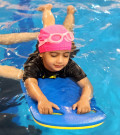
How to do a Bridge While Lying on Their Back in Gymnastics
2024-02-04 - gymnasticGymnastics, a sport requiring a unique blend of strength, flexibility, and grace, has gained popularity for its challenging yet rewarding nature. Among the various maneuvers and positions, the bridge stands out as a fundamental element, crucial for both beginners and advanced gymnasts.
Understanding the Bridge in Gymnastics
In gymnastics, the bridge is a foundational move that enhances flexibility and contributes to overall body strength. Its importance lies not only in its aesthetic appeal but also in its ability to improve posture and core stability.
Getting Started: Basic Bridge Form
To embark on your bridge journey, begin with a basic form. Lie on your back, bend your knees, and place your palms by your head, fingers pointing toward your shoulders. Press through your hands and feet, lifting your torso off the ground. Be mindful of proper alignment to avoid strain on your lower back.
Progressive Exercises to Improve Bridge Flexibility
As you grow more comfortable with the basic bridge, gradually introduce variations and stretches. Incorporate moves like the camel pose and upward-facing dog into your routine to target different muscle groups and enhance flexibility.
Safety Measures in Bridge Training
Before attempting any bridge exercises, it's crucial to warm up adequately. Focus on stretching your back, shoulders, and hip flexors to prepare your body for the demands of the bridge. Maintaining proper form is essential to prevent injuries, so listen to your body and avoid overextending.
Addressing Common Challenges
Many individuals face challenges like fear or discomfort when attempting the bridge. Practice mindfulness and breathing techniques to overcome these obstacles. Additionally, addressing muscle stiffness through regular stretching routines will contribute to a more fluid bridge movement.
Incorporating Bridges into Your Routine
Consider integrating bridge exercises into your gymnastics routine two to three times a week. Aim for consistency and gradually increase the duration of your bridge holds. This will not only improve flexibility but also contribute to better overall performance in gymnastics.
Advanced Bridge Techniques
For advanced gymnasts, explore challenging variations such as the one-arm bridge or the backbend. These moves not only showcase your progress but also provide an additional layer of difficulty to your gymnastics routine.
Benefits beyond Flexibility Core Strengthening
Beyond flexibility, bridge exercises play a crucial role in strengthening your core muscles. The engagement of the abdominal muscles, lower back, and hip flexors contributes to improved stability and balance during gymnastic performances.
Testimonials and Success Stories
Real-life success stories of individuals who diligently incorporated bridge exercises into their routine can be incredibly motivating. These stories serve as a reminder that progress takes time, dedication, and a consistent effort to overcome challenges.
Common Myths About Bridge Training
Dispelling common myths, such as the belief that bridge exercises are only for advanced gymnasts, is essential. Bridge training is adaptable to various skill levels, and with proper guidance, anyone can benefit from incorporating it into their gymnastics journey.
Nutritional Support for Flexibility
Nutrition plays a vital role in supporting flexibility. Including foods rich in vitamins and minerals, such as leafy greens and omega-3 fatty acids, can contribute to joint health and overall flexibility.
The Connection between Bridges and Gymnastics Performance
Understanding how bridge exercises contribute to overall gymnastics performance provides athletes with a strategic advantage. Incorporating bridge elements into routines enhances fluidity and adds an extra layer of complexity to performances.
Tips for Coaches and Instructors
Coaches play a pivotal role in guiding gymnasts through their bridge training. Tailoring exercises to individual needs, providing constructive feedback, and emphasizing the importance of proper form are key aspects of effective coaching.
Conclusion
In conclusion, mastering the bridge in gymnastics is a journey that combines patience, consistency, and a commitment to continuous improvement. Whether you're a beginner or an advanced gymnast, the bridge offers a multitude of benefits beyond flexibility, contributing to overall athleticism and performance.
.






.jpg)











































































































































































































